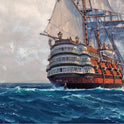1 franc Graziani (1943)
In the world of numismatics, there are rare coins, very rare coins, extremely rare coins, and finally the rarest and unique coins.
This 1 franc Graziani undoubtedly belongs in this final category.
To tell the truth, there are only two known examples of this version of a trial strike on a large planchet in existence.
France 1 Franc
Graziani, 1943, Algiers, Engraver Specimen/Trial, Aluminum
When we say rarest and unique, it’s not something we say lightly...
PROVISIONAL GOVERNMENT AND ORIGINS
The year is 1943 and we are in Algiers the White. The French Committee of National Liberation, a provisional government entrusted with preparing the liberation of occupied France and considering the Vichy regime to be illegitimate, has just been established there.

Declaration of June 3, 1943
With Generals de Gaulle and Giraud as presidents,
(...) The Committee of National Liberation shall continue, in close collaboration with all the Allies, to fight the common battle with the aim of complete liberation of the French territories and all Allied territories until the total victory over all of the enemy powers.
The Committee solemnly undertakes to restore all French liberties, the laws of the Republic, and the republican regime, completely destroying the regime of arbitrariness and personal power imposed on the country today.
CREATION, COPY, AND MINTS
There are also concerns regarding the currency.
There is no mint in Algiers, and the decision is finally taken to fall back on the offer of a private company: UMA (African Metallurgical Union).
The type of coin chosen is the Morlon franc of 1941 and the Algerian engraver Jean Graziani is entrusted with the task of reproducing the engraving.
Coin France
Morlon, 2 Francs, 1941, Paris, AU(50-53), Aluminum, KM:886a.1
The year of production will be 1943 and Jean Graziani will give the figure of the Republic a more severe line on the obverse than on the Morlon version. He will also add a little more detail to the horns of plenty on the reverse. The edge will be smooth.
OBSERVE : on the left, Morlon's engraving, on the right, Graziani's.
REVERSE : on the left, Morlon's engraving, on the right, Graziani's.
Two workshops will be responsible for the production of the coins, with varying degrees of success due to technical limitations. The geopolitical situation also means that the supply of metal is equally complicated.
The result: its zinc coins vary in their weight. Despite the difficulties, an FCNL ordinance is drafted on August 26, 1943, with the aim of minting and creating the coin. It even provides for the future minting of 2-franc and 50-centime coins. However, delays and hesitations continue to accumulate. In the end, the ordinance is never signed by the Commissioner of Finance, the order with UMA is canceled, and the coins already produced, rendered de factor illegal, will never enter circulation. The story of an aborted currency... Ultimately, according to the Bulletin Numismatique No. 90, only the following examples are listed:
![]()
INVENTORY
BE WARY OF FAKES
There have been several attempts to pass off examples of the 1948 Morlon franc as the 1943 version. Always pay attention to the year of production!
Coin France
Morlon, Franc, 1948, Beaumont - Le Roger, AU(50-53), Aluminum
Thanks to: Maxime Tobola
Translation: Michael Wright
Illustrations:
- "Open air theater, Algiers" by Albert Marquet (1942) (CC), Fondation Bemberg, photograph by Didier Descouens
- Biscuit box illustration (Public domain)
Sources:
- https://fr.wikipedia.org/wiki/Comit%C3%A9_fran%C3%A7ais_de_lib%C3%A9ration_nationale
- https://www.bulletin-numismatique.fr/bn/pdf/bn184.pdf (page 30)
- https://www.bulletin-numismatique.fr/bn/pdf/bn090.pdf (page 21)
- http://www.infonumis.info/historique&description/gouv.provisoire/index.htm
- https://mjp.univ-perp.fr/france/co1943cfln.htm


















